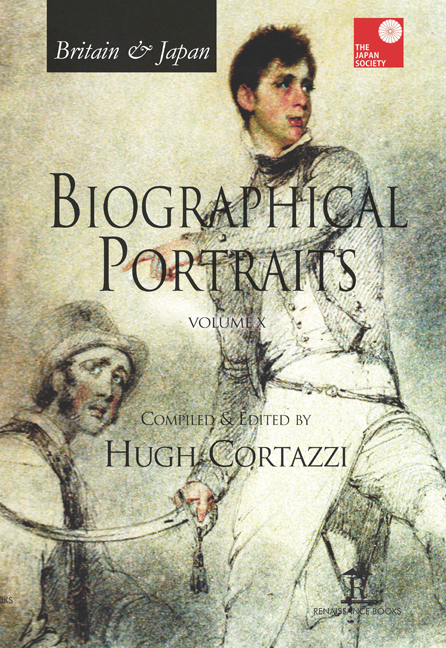Book contents
- Frontmatter
- Dedication
- Contents
- Introduction
- List of Contributors
- Index of Biographical Portraits in Japan Society Volumes
- PART I BRITAIN IN JAPAN
- PART II JAPAN IN BRITAIN
- Select Bibliography of Works in English on Anglo-Japanese Relations [Compiled by Gill Goddard – Retired East Asian Studies Librarian, University of Sheffield]
- Select Bibliography of Works in Japanese on Anglo-Japanese Relations [Compiled by Akira Hirano, SISJAC]
- Index
67 - Netsuke and Inrō collectors in the Nineteenth and Twentieth Centuries
Published online by Cambridge University Press: 07 May 2022
- Frontmatter
- Dedication
- Contents
- Introduction
- List of Contributors
- Index of Biographical Portraits in Japan Society Volumes
- PART I BRITAIN IN JAPAN
- PART II JAPAN IN BRITAIN
- Select Bibliography of Works in English on Anglo-Japanese Relations [Compiled by Gill Goddard – Retired East Asian Studies Librarian, University of Sheffield]
- Select Bibliography of Works in Japanese on Anglo-Japanese Relations [Compiled by Akira Hirano, SISJAC]
- Index
Summary
INTRODUCTION
COLLECTING AND CATALOGUING specimens and objects had been a popular diversion among the privileged classes, who amassed their cabinets of curiosities: butterflies, birds, plants, all manner of natural life. The most wealthy were also much taken with fragments from ancient civilizations and exotic objects brought back from foreign voyages. By the nineteenth century the Industrial Revolution had created a new class of self-made men with considerable fortunes and the craze for collecting took hold. It was not uncommon for a gentleman to create a private exhibition in his grand home for the enjoyment of his social circle. Such a display would attest to the scholarly sophistication of the host.
Although the British Museum had been established in 1753, access had been limited to those with appointments. In an attempt to relax these constraints in 1810 the system was changed to allow access three days a week to those of ‘decent appearance’. Robert Peel as home secretary in 1822 decreed that art and culture were a beneficial influence that should be accessible to all sections of society.
The Great Exhibition of 1851, organized by Henry Cole and Prince Albert was the first international exposition of manufactured objects, bringing objects from other lands to an eager audience. This was essentially a commercial enterprise of limited appeal to the aristocracy. At much the same time Japan was being re-opened to the world. This enabled eager travellers to bring back examples of Japanese culture to Europe. A craze for all things Japanese began. This was further encouraged by ‘The Japanese Village,’ in Knightsbridge from 1885 till 1887. By February of its final year it was estimated that it had attracted over a million visitors. Liberty’s opened its emporium in Regent Street in 1875, while Blairman was established in the elegant Welsh resort town of Llandudno in 1884. Both offered decorative oriental objects for sale among which netsuke were a popular curiosity. Blairman would hold auctions of goods in the summer months, when the town would be buzzing with members of high society. World Expositions in London, Paris and Vienna offered a fascinating glimpse of Japan to visitors. In 1900 the Japanese company Yamanaka and Co. opened its doors and five years later was granted the Royal Warrants of King George V and Queen Mary.
- Type
- Chapter
- Information
- Britain & Japan Biographical Portraits Vol X , pp. 761 - 772Publisher: Amsterdam University PressPrint publication year: 2016



